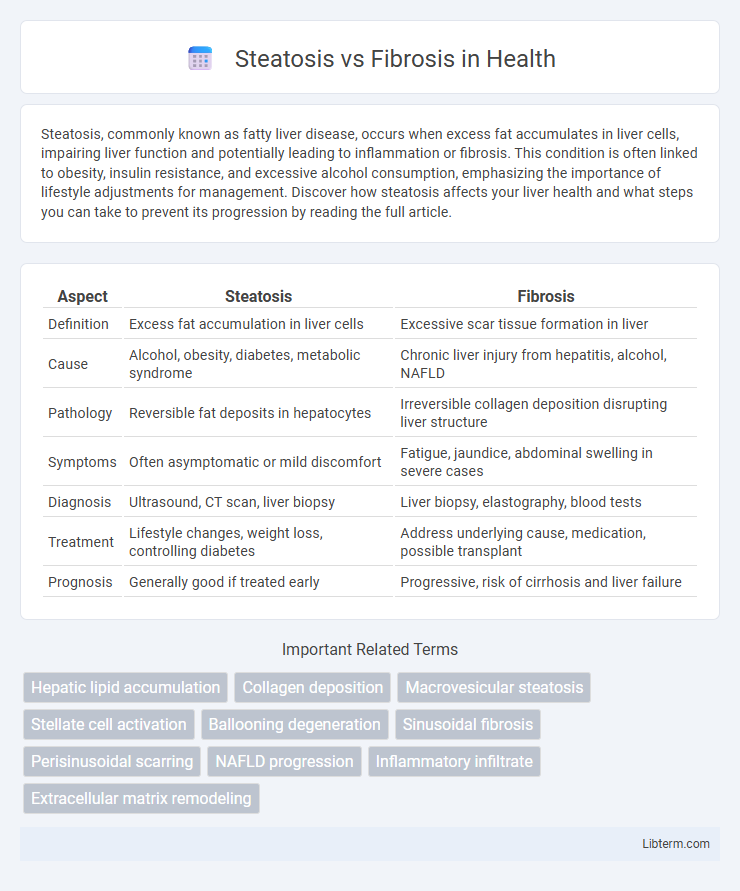Steatosis, commonly known as fatty liver disease, occurs when excess fat accumulates in liver cells, impairing liver function and potentially leading to inflammation or fibrosis. This condition is often linked to obesity, insulin resistance, and excessive alcohol consumption, emphasizing the importance of lifestyle adjustments for management. Discover how steatosis affects your liver health and what steps you can take to prevent its progression by reading the full article.
Table of Comparison
| Aspect | Steatosis | Fibrosis |
|---|---|---|
| Definition | Excess fat accumulation in liver cells | Excessive scar tissue formation in liver |
| Cause | Alcohol, obesity, diabetes, metabolic syndrome | Chronic liver injury from hepatitis, alcohol, NAFLD |
| Pathology | Reversible fat deposits in hepatocytes | Irreversible collagen deposition disrupting liver structure |
| Symptoms | Often asymptomatic or mild discomfort | Fatigue, jaundice, abdominal swelling in severe cases |
| Diagnosis | Ultrasound, CT scan, liver biopsy | Liver biopsy, elastography, blood tests |
| Treatment | Lifestyle changes, weight loss, controlling diabetes | Address underlying cause, medication, possible transplant |
| Prognosis | Generally good if treated early | Progressive, risk of cirrhosis and liver failure |
Introduction to Steatosis and Fibrosis
Steatosis, commonly known as fatty liver, involves the abnormal accumulation of triglycerides within liver cells, often linked to obesity, diabetes, and alcohol use. Fibrosis refers to the excessive buildup of extracellular matrix proteins, such as collagen, resulting from chronic liver injury and leading to scar tissue formation. Both conditions are critical stages in liver disease progression, with steatosis representing an early, reversible phase and fibrosis indicating a more advanced, potentially irreversible damage.
Understanding Liver Health
Steatosis, characterized by the accumulation of fat within liver cells, is often an early indicator of liver damage commonly associated with obesity, diabetes, and alcohol use. Fibrosis involves the excessive formation of scar tissue resulting from chronic liver inflammation, significantly impairing liver function and potentially progressing to cirrhosis. Differentiating between steatosis and fibrosis through imaging and biopsy is critical for assessing liver health and implementing targeted treatments to prevent irreversible damage.
What is Steatosis?
Steatosis, also known as fatty liver, is the accumulation of excess fat in liver cells, often caused by obesity, diabetes, alcohol consumption, or metabolic disorders. This condition disrupts normal liver function and can lead to inflammation, oxidative stress, and liver cell damage if left untreated. Unlike fibrosis, which involves the formation of scar tissue, steatosis is primarily characterized by fat infiltration without significant fibrosis or scarring.
Causes and Risk Factors of Steatosis
Steatosis, commonly known as fatty liver, is primarily caused by excessive alcohol intake, obesity, insulin resistance, and metabolic syndrome, leading to abnormal accumulation of fat in liver cells. Risk factors for steatosis include type 2 diabetes, high triglyceride levels, sedentary lifestyle, and poor dietary habits rich in saturated fats and sugars. In contrast, fibrosis results from prolonged liver injury and inflammation, where scar tissue gradually replaces healthy liver tissue, often progressing from conditions like steatosis or chronic hepatitis.
What is Fibrosis?
Fibrosis is the excessive accumulation of scar tissue in organs, often resulting from chronic inflammation or injury, particularly in the liver. This condition disrupts normal tissue architecture and impairs organ function by replacing healthy cells with fibrous connective tissue. In contrast to steatosis, which involves fat accumulation, fibrosis represents a more advanced stage of liver damage that can progress to cirrhosis if left untreated.
Causes and Risk Factors of Fibrosis
Fibrosis is primarily caused by chronic liver injury resulting from persistent inflammation, often triggered by viral hepatitis, alcohol abuse, or non-alcoholic fatty liver disease (NAFLD). Key risk factors include prolonged exposure to toxins, obesity, diabetes, and metabolic syndrome, which exacerbate liver cell damage and promote excessive extracellular matrix deposition. Unlike steatosis, which denotes fat accumulation in liver cells, fibrosis represents scar tissue formation aimed at repairing ongoing tissue injury, leading to liver stiffness and impaired function.
Key Differences Between Steatosis and Fibrosis
Steatosis is characterized by the abnormal accumulation of fat within liver cells, often linked to conditions such as obesity, diabetes, and alcohol consumption. Fibrosis involves the excessive formation of scar tissue in the liver as a response to chronic injury or inflammation, leading to the disruption of normal liver architecture. Unlike steatosis, fibrosis represents a progressive and potentially irreversible stage of liver damage, with higher risks of cirrhosis and liver failure.
Diagnosis: Steatosis vs Fibrosis
Steatosis is primarily diagnosed through imaging techniques such as ultrasound, CT scans, and MRI, which detect fat accumulation in liver cells, while biopsy remains the gold standard for definitive assessment. Fibrosis diagnosis relies on liver stiffness measurement via transient elastography (FibroScan) or magnetic resonance elastography (MRE), complemented by serum biomarkers and histological examination to evaluate the extent of scarring. Differentiating steatosis from fibrosis is crucial for disease staging and management, as imaging findings of fat infiltration differ significantly from fibrotic tissue remodeling.
Treatment Approaches for Steatosis and Fibrosis
Treatment approaches for steatosis emphasize lifestyle modifications such as weight loss, dietary changes, and increased physical activity to reduce liver fat accumulation. In contrast, fibrosis management targets underlying causes like viral hepatitis or alcohol use, with antifibrotic agents and medications such as angiotensin receptor blockers emerging to halt or reverse liver scarring. Advanced fibrosis or cirrhosis may require more intensive interventions, including liver transplantation in severe cases.
Prevention and Lifestyle Recommendations
Steatosis prevention centers on maintaining a healthy weight through a balanced diet rich in fruits, vegetables, and whole grains, alongside regular physical activity to reduce liver fat accumulation. Fibrosis management emphasizes controlling underlying causes such as chronic hepatitis or alcohol use by avoiding hepatotoxic substances and adhering to medical treatments. Both conditions benefit from lifestyle changes like limiting sugar and saturated fat intake, quitting smoking, and routine monitoring to prevent progression to severe liver disease.
Steatosis Infographic

 libterm.com
libterm.com